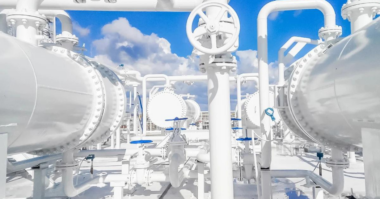It seems a little strange that a material first developed to replace a material as nasty as asbestos would then be recruited by the Navy to replace a metal as pure and precious as silver. Odd as it may be, it’s also part of the history of flexible graphite.
Flexible graphite seals and gaskets were first developed in the late 1970’s as effective, non-toxic substitutes for asbestos. By the early 90s, however, the U.S. Navy’s nuclear fleet had a different problem to solve. The high-pressure valve seals on nuclear-powered ships were made of silver-coated metal. The relatively soft silver coating provided a secure seal on imperfect valve surfaces. But the cost of silver was prohibitive, and the Navy wanted a more economical alternative.
Dick Dudman, the Chief Engineer and flexible graphite pioneer at EGC Enterprises, was there when the Navy got in touch. “About 20 years ago, a Navy consultant named Paul Toupin called and was interested in putting flexible graphite in the nuke’s pressure valves as a sealing element. An edict had come down, and the Naval brass wanted the silver out.”
Toupin suspected — and Dudman knew — that flexible graphite was a made-in-heaven product for replacing the silver-coated metal seals. Soft and resilient, flexible graphite has the ability to micro-seal a surface. Its compressed graphite flakes are small enough to fill imperfections and anomalies in the surface; and when the seal is built at the proper thickness, it will also adjust for out-of-flatness conditions.
A flexible graphite seal can absorb imperfections and still have enough friction on the mating surfaces to remain in position during the loading and under system pressure. And because flexible graphite has no property loss in the presence of nuclear radiation, it was a natural fit for the Navy’s nuclear pressure valve application.
Of course, Dick Dudman also knew that the flexible graphite material alone was not enough to solve the Navy’s problem. It had to be engineered to fit the application. “You don’t just wad up a bunch of graphite, throw it in a cavity and squeeze it. We had to contain the graphite in anti-extrusion stainless steel caps. That way the seal would have the proper amount of mass to reach density and still fit in exactly the same location as the metal seal it replaces.”
Fortunately, EGC Enterprises already had a head start in the design of such a seal. “We were already in the business of making pressure seals for Arizona Public Service (APS), a public electric power utility. So when Paul Toupin said he was interested in replacing a metal seal with a graphitic one, I suggested he go to a conference in Florida to hear Bill Lehman from APS talk about how our seals worked for APS in their nuclear application.”
As it turns out, APS provided much more than a first-party endorsement — the testing data that the Navy required was actually done by APS in 1999 at one of their facilities. “They used a fixture and loaded and unloaded it temperature-wise, pressure-wise to simulate as many years as possible,” says Dudman. “We spent about a week in the facility and knowing that this was an accelerated test, just extrapolated out the data and that was about 26 years of life — much better than the metal seal. Not many pressure seals even last that long. Even the plants last only about 40 years. So the Navy used the recommendation, and we had the authority to proceed.”
Subsequently, the Navy conducted its own tests, most notably 500-hour shock and steam tests performed in 2003 by Target Rock at its steam test facility. The original results were confirmed. The EGC flexible graphite pressure seal performed without any leakage and hit the mark on compressibility.
The sealability benefits of flexible graphite over metal have far reaching implications. As one experienced hand from APS noted, metal seals have only a 60% chance of sealing. When they don’t seal, they must be welded or filled with concrete. And in many applications, there is no access to the valve until the entire system is shut down for maintenance.
To this day, EGC’s is the only graphite pressure seal tested and approved by the U.S. Navy for use in Standard Navy Control Valve designs aboard nuclear-propulsion vessels. Having replaced both asbestos and silver, it still sails under the U.S. flag on a number of ships.
How Flexible Graphite Learned to Satisfy the Need for Speed
Tested and approved by the Navy in 2003 for use in nuclear powered ships, the EGC Thermafoil flexible graphite pressure seal seemed to be poised for big things in the general power generation market. In fact, flexible graphite tests performed by electrical power provider, Arizona Public Service (APS), confirmed the Navy’s projected lifespan of 26 years for high pressure flexible graphite seals, much longer than the service life of metal seals.
Then, also, flexible graphite speeds up and simplifies the seal replacement process. Metallic replacement seals require a very clean surface. If the valve surface is pitted, scratched, out of round, or irregular in any way, the metallic seal has little chance of working. Flexible graphite, on the other hand, absorbs these irregularities by conforming to the worn valve surface. Where a metal seal has a small clearance between the body ID and the OD of the seal, flexible graphite conforms and adapts. It is an insanely forgiving material.
And at the other end of service life, flexible graphite is easy to remove and replace. According to Dick Dudman, an engineer and flexible graphite pioneer at EGC Enterprises, “When you go to replace a worn metal seal, you find that it has bonded itself to the components inside the valve. Major work has to be done to get it out. Some of seals have to be cut or forced out with hammers, jackhammers, and come-a-longs. And the removal process does so much damage that the ID of the valve body has to be re-machined.”
A graphite seal, because it’s so compressible, just doesn’t stick. Says Dudman, “When it’s time to change the seal, and you open up the screws, the bonnet will just drop away. You just lift it out the old graphite seal by hand, put the new one in, and button the valve right back up again.”
In fact, the ease-of-replacement benefits of flexible graphite seals are so pronounced, they should (and probably would) have taken the power generation market by storm in 2003 — if not for one, slight problem: they simply took too much time to make. There was a need for speed.
Dick Dudman remembers it well: “EGC graphite pressure seals required expensive tooling, and it took weeks to build. The only business we would get was when the power plant didn’t care what it cost, they just had to have the seal.”
To be of real service to the power generation industry, EGC had to create a way to service the needs of a plant during “outages,” where the plant would shut down twice a year, for a few weeks, to do all maintenance work. EGC had to develop a quicker process with no tooling to meet this small window of opportunity.
“Through our proprietary process, we configure the flexible graphite, using valve body and component dimensions, to ensure that the installer is working with a seal of sufficient strength, integrity, and proper mass. It’s a product engineered specifically for their application and it’s all accomplished without expensive tooling,” said Dudman.
Finally, EGC had a seal that could reach power plant service departments in days. Adds Dudman, “Instead of sourcing a new tool for every valve body, our process can make graphite pressure seals from 3” to 24” valves. The new VSG (Vertically Spiraled Graphite) is designed to deliver the same safe performance as our original die-molded seals. And we’re proud to boast a 100% performance rating and zero-failure track record with ALL of our graphite pressure seals.”
The new VSG was introduced in 2008, and has already begun to change the way that power plants service their high-pressure valves. Power customers don’t have to pay tooling cost and receive the product when they need it. Coupled with our new “Fast-Trac” delivery program, VSG service can be measured in days not weeks.
How Flexible Graphite Got on the Fast-Track for Service Pro’s
Hands down, flexible graphite has proven its superiority to metal as a gasket material for high-pressure seals. It installs easier and seals more reliably because it fully conforms to the valve surface. Since it doesn’t stick or bond to the metal, it removes quickly and easily without any need for chisels, grinders, or jackhammers — you just lift it out. Lifespan? It’s rugged enough to have satisfied U.S. Navy durability standards for seagoing nukes.
All of these factors make EGC Thermafoil Pressure Seals a preferred choice for OEM valve manufacturers. But for plant service professionals, there’s an issue that is perhaps even more important than functional superiority.
“‘How fast can you get it to me?’ That is the first question you’re going to hear from a service guy,” says Dick Dudman, an engineer and flexible graphite pioneer at EGC Enterprises. “He’s got a unit shut down with management nipping at his heels to get back online, and he’s in a hurry. And back in 2003, when we first developed the die-molded EGC Thermafoil flexible graphite pressure seal, we didn’t have a very good answer. Average turnaround time was six weeks.”
In 2008, it got a lot better. EGC introduced a new seal called VSG that cut turnaround time to a few days. They found a way to eliminate the need for production tooling by creating a highly densified, EGC flexible graphite “pressure seal profile” and applying anti-extrusion stainless steel top and toe caps.
Dick Dudman again: “VSG delivers the same performance as our original molded seals — with delivery times a service manager can appreciate. Appreciate, but not love. The question was: could we find a way to do it even faster?” The most time-consuming part of VSG production is the top and toe caps. Their purpose is to contain the graphite under pressure, to maintain the integrity of the seal by preventing extrusion. Made from flat stainless steel in a machine shop, they require precision equipment and a talented machinist.
EGC discovered that extrusion could be prevented using “edges” instead of full-faced caps. These containing edges can be made of wire instead of machined caps. And the wire can be fashioned and applied in EGC’s shop on the same day. The result: a new seal called the VSG Pro that can be completed the same day the order comes in and shipped via the quickest service available.
Now service managers can get custom-designed flexible graphite seals faster then anyone could have predicted just a few years ago. With no production tooling, the price point is significantly lower; in fact the VSG Pro is cost competitive with its metal counterpart.
How Does the VSG Pro Perform Once in Place?
“When the product is installed, there is no difference,” says Dudman. “There’s the same amount of graphite in the Pro as there is in the VSG and our original die-molded seals. All graphite seals resist valve pressure throughout the entire body of the seal. It’s not like a metal seal where all the energy is centered on the toe alone. In other words, graphite is under less stress in the cavity. The bottom line is that all three EGC flexible graphite seals are equally superior to metal seals.”
The VSG Pro does have different look, however. Because it’s not squeezed into a mold or compressed into metal caps, there must be some method of gluing or taping or shrink tubing to make sure all the components stay as one unit when dropped in to the valve. The EGC solution is simple and economical. Dick Dudman again: “We wrap them in a few locations with cellophane tape. That way, it’s easy to just drop the seal into the valve. Then, when production is resumed and the valve gets hot, the tape just disappears.”
And all that’s left is the superior performance of the VSG Pro pressure seal.




